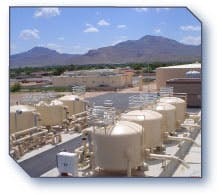In October 2002, the U.S. Environmental Protection Agency (EPA) proposed a new standard of 10 parts per billion (ppb) of arsenic at the entry point to a distribution system, the El Paso Water Utilities Public Service Board determined to achieve compliance at those 46 wells – where concentrations were as high as 30 ppb – by the January 2006 deadline.
El Paso Water Utilities initiated a two-year pilot project to test treatment technologies for arsenic removal.
Arsenic removal options
During the project, researchers tried and rejected as inappropriate or ineffective several arsenic removal technologies including coagulation-microfiltration and coagulation followed by cloth filtration.
The $50 million capital cost included design and construction of the facility and installation of large-diameter pipes and pumping stations.
The facility was designed as a conjunctive use plant, so that, with added treatment processes, it can treat Rio Grande water in the future, if the city is able to acquire additional water rights.
Three smaller water treatment facilities totaling 50 mgd were constructed for $26 million to remove arsenic from water drawn from the Hueco Bolson. A wellhead media adsorption system treats groups of wells at existing sites in northeast and east El Paso using granular iron media.
Pilot testing
During pilot testing, El Paso Water Utilities tried eight different adsorption products, finally selecting the Bayoxide E33 arsenic removal media from Severn Trent Services as the most cost effective. The Cielo Vista arsenic-removal facility treats water from 10 wells in east El Paso. Farther east of the city are five wells whose water is treated in the new Eastwood facility. The Northeast facility treats water from 16 wells.
Eleven additional wells, which had not been used for more than 20 years because water quality did not meet drinking water standards, were equipped with skid-mounted reverse osmosis systems to remove arsenic and minerals.
At the three plants utilizing the Severn Trent Services technology, raw water was fed into the adsorption system, with chlorine and carbon dioxide added to acidify and oxidize the water prior to contact with the arsenic removal media.
Upon exiting the media, the water is essentially arsenic-free. Concurrently, raw water bypasses the granular iron media and is combined with the treated water at the conclusion of the arsenic removal process, raising the arsenic levels, but still to ranges below the new federal standard. Sodium hydroxide is added after the blending of the two waters to de-acidify the water.
Regardless of the arsenic removal technology employed, the treated water coming out of the treatment plant is blended with untreated water to achieve a 5-8 ppb overall arsenic concentration in the blended water – well within EPA guidelines.
The construction of the arsenic treatment facilities resulted in a 19 percent rate increase. But through an excellent public information and education program, El Paso Water Utilities has garnered strong support from its rate-paying customers. According to company officials, water is a big issue in the city, and regulatory compliance and customer satisfaction are both vitally important.


